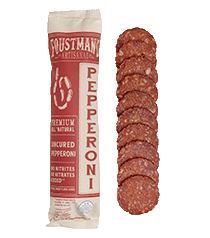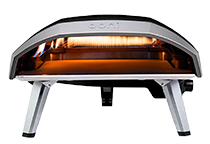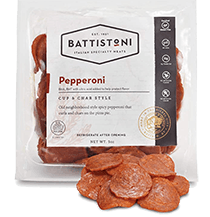Determining the calorie content in a slice of pepperoni pizza is a common concern for those who enjoy this popular dish while trying to maintain a balanced diet. Calories in pepperoni pizza can vary depending on several factors, including the size of the slice, the thickness of the crust, the amount of cheese and pepperoni used, and the method of preparation.
With its rich layers of cheese, spicy rounds of pepperoni, and carbohydrate-heavy dough, pepperoni pizza presents a combination of ingredients that are delicious but calorically dense. So how many calories are in a slice of pepperoni pizza?

The caloric content of a single slice of 14-inch pepperoni pizza typically hovers around the 300-calorie mark. However, variations from different pizza outlets can alter this figure. For example, one chain’s medium-sized slice could contain 230 calories, whereas another’s might be closer to 280 calories.
Given the variability in manufacturers’ recipes and serving sizes, it’s important for those monitoring their caloric intake to check the specific nutritional information provided by the pizza source. Furthermore, the toppings and crust type play a significant role in the total caloric count, with thicker crusts and additional toppings leading to higher calorie amounts per slice.
Key Takeaways
- A slice of 14-inch pepperoni pizza typically contains approximately 300 calories.
- Specific calorie counts can vary based on the pizza source and ingredients used.
- Factors like crust type, toppings, and slice size are critical in determining a slice’s calorie content.
Table of Contents
Nutritional Overview of Pepperoni Pizza

When I analyze the nutritional content of how many calories are in a slice of pepperoni pizza, I’m looking at a significant amount of calories typically ranging from 300 to 450 calories per slice. The variation largely depends on the size and specific recipe used. In terms of macronutrients, the focus is generally on the balance of proteins, carbohydrates, and fats.
Proteins are essential for repairing tissues and maintaining a healthy immune system. A slice of pepperoni pizza approximately contains between 13 to 15 grams of protein.
Carbohydrates provide the body with energy, and you can expect about 33 to 42 grams in a slice, which includes both simple and complex carbs. These are important for fueling the body, especially for those who lead active lifestyles.
Moving onto fats, the total fat in a slice can be around 12 to 14 grams. Within this total fat content, the breakdown typically includes:
- Saturated fat: about 5.7 grams
- Polyunsaturated fat: roughly 2.3 grams
- Monounsaturated fat: close to 4.3 grams
The consumption of too much saturated fat can raise cholesterol levels, so it’s something to be mindful of when eating pizza.
Speaking of cholesterol, a slice of pepperoni pizza contains around 28 milligrams. Keeping a check on cholesterol intake is vital for cardiovascular health.
For other nutrients like sodium, pizza can be quite high, contributing significantly toward the daily limit. However, exact amounts can vary and should be checked based on individual pizzas.
Fiber content is often low in a slice of pepperoni pizza, and sugars, while not significant, are present due to the natural sugars in tomatoes and potentially added sugars in various pizza sauces.
In terms of vitamins and minerals, pizza can offer some calcium and iron, primarily from cheese and the enriched flour in the crust, respectively.
Regarding the daily values, it’s essential to consider that these percentages are based on a 2,000-calorie diet, and the actual needs may vary.
Lastly, the total carbohydrate usually makes up 46% of the nutritional profile, with protein and fat accounting for 18% and 37% respectively. My advice is to consider these figures within the context of an overall balanced diet.
The Role of Ingredients in Caloric Content
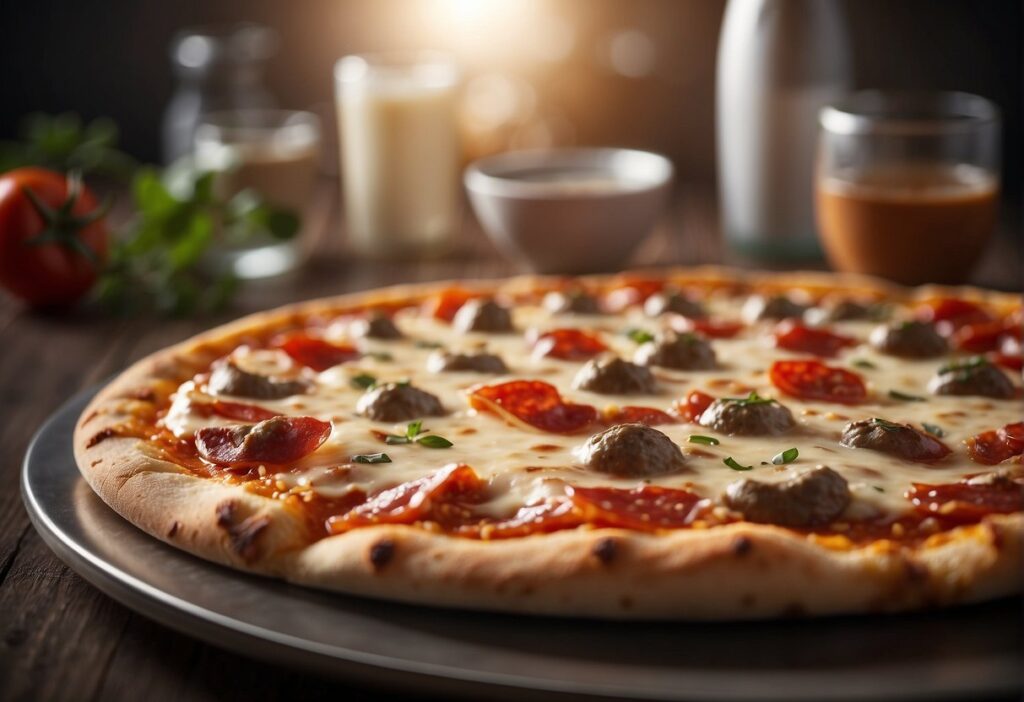
When analyzing how many calories are in a slice of pepperoni pizza, I consider the individual contributions of the crust, cheese, pepperoni, sauce, and other toppings. Each ingredient has a distinctive impact on the nutritional value and calorie count.
Crust Variations
I’ve observed that the crust serves as the foundation for caloric variation. A thin crust typically contains fewer calories than a thick, deep-dish or stuffed crust. On average, the crust can contribute between 50 to 300 calories to a pizza slice, with a standard fast-food chain’s cheese pizza slice (107g) having around 35.6g of carbohydrates.
Cheese and Its Nutritional Impact
Cheese adds richness and saturated fat to pepperoni pizza, and it also significantly affects the caloric content. For instance, a regular cheese pizza slice from a fast-food pizza chain carries about 10.4g of fat. Variations in cheese type and amount can cause the calorie range to fluctuate, with more cheese translating to an increase in both calories and sodium.
Pepperoni and Processed Meat Considerations
Pepperoni, a processed meat, is a key contributor to the calorie count. It adds not only flavor but also additional saturated fat and sodium. A single slice of pepperoni pizza can range between 250 to 400 calories, part of which comes from the 12-18 grams of fat present in the pepperoni itself.
Sauce and Additional Toppings
The sauce, generally tomato-based, contributes a marginal amount of calories but can be a source of added sugars and sodium. Extra toppings like vegetables tend to add minimal calories but increase the nutritional value, while additional meats can significantly increase the caloric density. A typical pizza sauce may contain between 20 to 80 calories per serving, depending on the recipe and serving size.
Size and Servings Matter
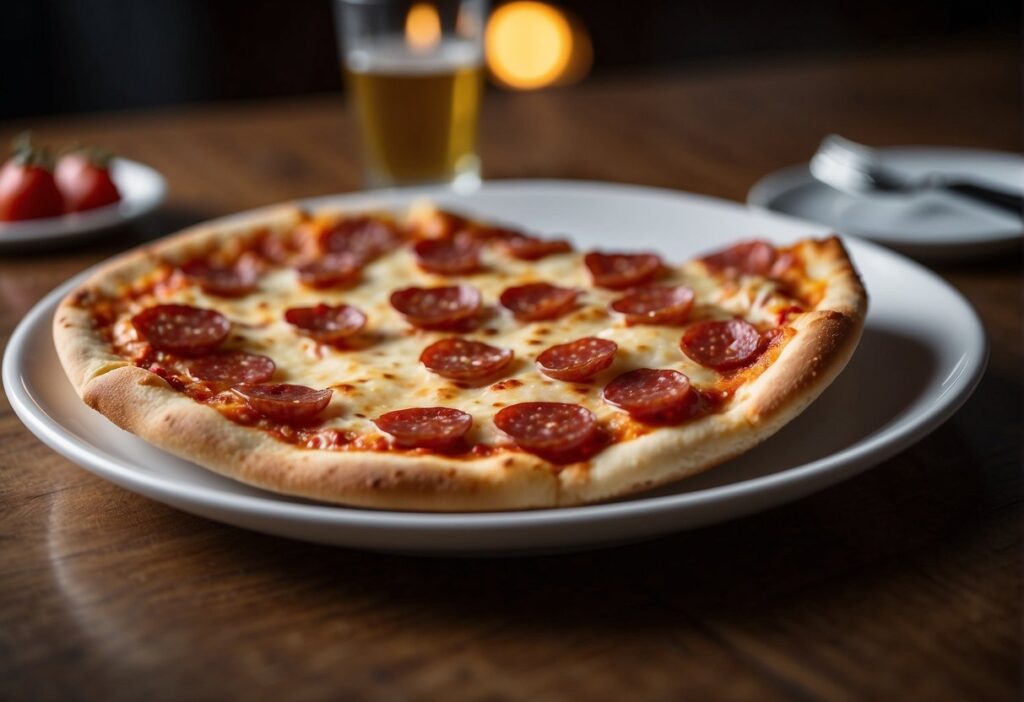
When discussing how many calories are in a slice of pepperoni pizza, I cannot overstate the impact of size and serving sizes. A single slice’s caloric value can vary widely, depending on the dimensions of the pizza itself. For instance, a slice from a medium-sized pizza may differ significantly from a slice of a large pizza due to the larger portion sizes.
Medium Pepperoni Pizza
- Papa John’s Original Crust: Approximately 230 calories per slice
- Little Caesars’ 14-inch: Around 280 calories per slice
Larger Pizzas
- 16-inch Pepperoni Pizza: Roughly 390 calories per slice
- 18-inch Pepperoni Pizza: Typically 480 calories per slice
The calorie content also hinges on the thickness of the crust, amount of cheese, and servings of pepperoni. It’s vital to observe that as a pizza’s diameter increases, the surface area grows, leading to larger slices and more calories per slice. For example, a 14″ pizza has a greater area than a 12″ pizza, yielding heftier portions.
When I evaluate servings, I consider both the size of the pizza and the number of slices it is cut into. A standard pizza typically offers between 8 to 12 slices. Therefore, I advise anyone looking to manage their calorie intake to be mindful of both the slice size and the number of slices they consume. By staying informed about the dimensions and servings, I can maintain better control over my caloric intake when enjoying pepperoni pizza.
Understanding How Many Calories are in a Slice of Pepperoni Pizza
When I assess the calorie content of a slice of pepperoni pizza, two major factors come into play: the crust thickness and the specific brand. The crust type significantly affects the calorie count, and each brand has its own recipe that can alter the nutritional value.
Thin Crust vs Thick Crust Calories
The type of crust is a defining factor in the calorie count. Here’s a quick breakdown:
- Thin Crust: On average, a slice of thin-crust pepperoni pizza contains fewer calories than its thick-crust counterpart. This stems from the reduced amount of dough and, consequently, fewer carbs.
- Thick Crust: A standard slice of thick-crust pepperoni pizza has more calories, primarily due to a larger amount of dough, which increases the overall calorie density of the slice.
| Crust Type | Average Calories per Slice |
|---|---|
| Thin Crust | 250-300 calories |
| Thick Crust | 300-350 calories |
These figures are approximations, and the actual values can vary based on the amount and type of toppings and the pizza’s overall size.
Variation By Pizza Brands
I will now look into how different pizza brands affect the calorie content per slice:
- Domino’s Pizza: A slice of Domino’s thin-crust pepperoni pizza falls towards the lower end of the calorie range provided by most chain pizzerias.
- Pizza Hut: Opting for a slice of Pizza Hut’s hand-tossed crust will typically result in a higher calorie count, especially if it’s from a more indulgent range like their stuffed crust options.
It’s noteworthy that the size of a slice plays a crucial role. For instance, Pizza Hut often cuts its pizzas into fewer slices than Domino’s, contributing to larger slices and therefore more calories per slice. Here is a side-by-side look at their offerings:
| Brand | Crust Type | Average Calories per Slice |
|---|---|---|
| Domino’s Pizza | Thin Crust | approximately 250 calories |
| Domino’s Pizza | Thick Crust | up to 350 calories |
| Pizza Hut | Thin Crust | around 283 calories |
| Pizza Hut | Stuffed Crust | approximately 260 calories |
In conclusion, my analysis indicates that a slice of pepperoni pizza’s calorie content varies with crust thickness and pizza brand. Thin crusts and certain brands like Domino’s tend to be on the lower end, while thick and specialty crusts, particularly from brands like Pizza Hut, can be higher in calories.
Comparative Analysis of Different Pizza Types
I understand that the calorie content of pizza can vary widely depending on the toppings used. In this section, I’ll examine how different toppings affect the nutritional profile of a pizza slice.
Meat Toppings and Calorie Comparison
Meat toppings like pepperoni and sausage significantly increase the calorie count of a pizza slice. A slice of pepperoni pizza, for example, contains approximately 300-350 calories, with fats contributing around 10-15 grams, and protein around 12-15 grams. In contrast, a slice of cheese pizza usually has fewer calories—around 285 calories, with 10.4 grams of fat and 12.2 grams of protein. Carbohydrates remain relatively consistent, with pepperoni pizza containing 25-30 grams and cheese pizza about 35.6 grams.
Vegetable Toppings and Nutritional Value
Adding vegetable toppings to a pizza can influence the calorie count and nutritional value. Vegetables add fiber and vitamins while keeping the calorie increase minimal. For example, a slice of pizza with veggie toppings like bell peppers, onions, and mushrooms may have more fiber but won’t add as many calories as meat toppings. Typically, the carbs in a veggie pizza slice remain around 30 grams, with a moderate amount of protein due to the cheese.
Specialty Pizzas and Dietary Considerations
Specialty pizzas that cater to specific dietary restrictions, such as gluten-free or cauliflower crust options, also offer different calorie counts. A gluten-free crust typically has a similar calorie range but might have more protein due to alternative flour blends. On the other hand, a cauliflower crust pizza is often lower in calories and carbs but may have less protein unless additional toppings or cheeses are added. It’s important for individuals to check the specific nutritional information of these specialty pizzas as ingredients and portion sizes can cause variation.
Health Aspects of Eating Pepperoni Pizza
When assessing the health aspects of consuming pepperoni pizza, it’s important to pay attention to the nutritional content. As someone who actively monitors dietary intake, I focus on several key components: calories, sodium, fats, and other nutrients such as dietary fiber and unsaturated fats when considering how many calories are in a slice of pepperoni pizza.
Nutritional Breakdown:
- Calories: A typical slice of pepperoni pizza can provide about 300 to 450 calories, depending on the size and ingredients.
- Fats: Expect around 13g of total fat, with 5.7g being saturated fat, which is 29% of the daily recommended intake.
- Sodium: One slice may contain up to 760mg of sodium, accounting for about 33% of the daily limit.
- Dietary Fiber: It usually offers around 2.6g of dietary fiber.
- Protein: Pepperoni pizza has roughly 13g of protein per slice.
As an advocate for a health-conscious lifestyle, I understand that these elements should be balanced within one’s overall diet to maintain good health. High sodium and saturated fats, for instance, can affect cardiovascular health and are linked to a higher mortality risk when consumed excessively.
Incorporating unsaturated fats instead of saturated fats can be a healthier choice, as they offer potential heart-health benefits. Maintaining portion control is vital for a healthy energy balance. While pizza can be part of a varied diet, it’s essential to consume it in moderation and balance it with foods rich in dietary fiber, vitamins, and minerals. This ensures that I’m not only enjoying my meal but doing so in a way that aligns with a healthy lifestyle.
Daily Values and Recommended Intake
When discussing the nutritional content of a pepperoni pizza slice, it’s crucial to understand the Daily Values (DV). These benchmarks provide guidance on how much of certain nutrients I should consume or not exceed each day.
Calories: A typical slice of pepperoni pizza averages around 300 calories, which I would consider in the context of a standard 2,000 calorie daily diet. This represents approximately 15% of my total daily calorie intake.
Fats: The total fat in a slice can reach 13 grams. Since the DV for fats is less than 78 grams, this amounts to roughly 17% of my daily fat intake. Out of this, saturated fat might be around 5.7 grams—already 29% of my daily limit of 20 grams.
Fiber: With about 2.6 grams of fiber per slice, I make progress towards the recommended daily intake of 28 grams, adding about 9% to my DV.
Sugars: A slice contains about 3.6 grams of sugars, and while there is no specific DV for sugars, it’s advisable to minimize intake.
Regarding micron
The Calorie Breakdown of Popular Pizzas
In my analysis of calorie content in popular pizza choices, I’ve gathered specific information regarding fast-food chains and frozen pizza brands, focusing on their pepperoni offerings which are high in demand.
Fast-Food Chain Pizza Calorie Guide
For many pizza lovers, fast-food chain pizzas are a go-to option for convenience and taste. Here’s a breakdown:
Domino’s Pizza 14″ Thin Crust Pepperoni Feast Pizza: Based on the nutrition facts, one slice contains:
- Calories: Approximately 340 calories
- Fat: 14g
- Carbohydrates: 29g
- Protein: 16g
Sbarro 14-Inch NY Pepperoni Pizza: Per slice, the calorie content and nutrition specifics are:
- Calories: About 460 calories
- Fat: 18g
- Carbohydrates: 53g
- Protein: 19g
Frozen Pizza Brand Nutritional Facts
Moving on to the convenience of frozen pizzas, let’s look at the details:
Stouffer’s French Bread Pizza Sausage & Pepperoni:
- Calories: 429 calories per serving
- Fat: 22g
- Carbohydrates: 44g
- Protein: 18g
Donatos Pizzeria Pepperoni Pizza, 14-Inch Famous Thin:
- Calories: On average, a slice is around 150 calories
- Fat: 5g
- Carbohydrates: 20g
- Protein: 8g
Given these figures, keep in mind that daily values and calorie needs vary based on individual dietary requirements and activity levels. The data reflects an estimation of nutritional content for pepperoni pizza from some popular pizza outlets and frozen brands.
Impact of Cooking Methods and Storage on Calories
When I consider how cooking methods influence the calorie content in a slice of pepperoni pizza, the primary factors include the type of crust and the amount of oil used. For instance, a deep-dish pepperoni pizza will generally contain more calories due to a thicker crust and potentially more oil. In contrast, a thin-crust pizza could have fewer calories.
Cooking Methods:
- Deep-Dish: can increase calorie count due to more dough and oil.
- Stone-Baked: may have less oil compared to pan pizzas, potentially reducing calories.
- Convection Oven: cooks pizzas evenly, which could affect the distribution of grease and, subsequently, calories.
When storing pizza, especially frozen varieties, the caloric content does not change significantly. However, the method of reheating can alter the calorie profile slightly.
Storage and Reheating:
- Microwaving: might lead to a softer crust, which doesn’t affect calories directly.
- Oven Reheating: retains the pizza’s original cooking conditions, maintaining its initial calorie content.
Particularly for frozen pepperoni pizzas or French bread pizzas, the caloric value per serving is usually mentioned on the packaging, assuming standard preparation methods. It is essential to adhere to these methods to ensure that the calorie content remains as stated.
Calories in Frozen Varieties:
- Frozen Pepperoni Pizza: typically listed per serving on the box.
- French Bread Pizza: calorie content can vary based on the amount of cheese and pepperoni.
By understanding these variables, I maintain a clear and accurate account of how many calories are in my slice of pepperoni pizza.
Making Healthier Pizza Choices
When I select a slice of pepperoni pizza, I’m aware that calories can add up quickly. To enjoy pizza while maintaining a healthier profile, I focus on macro-nutrient balance and portion control. By choosing a lighter crust density, I can reduce the caloric intake; a thin crust usually contains fewer calories than a thick, deep-dish or pan pizza base.
Here are a few tweaks I make for a healthier slice:
- Crust: I opt for a whole wheat crust when available, as it’s higher in fiber and nutrients.
- Cheese: I ask for less cheese, or sometimes choose part-skim mozzarella for its lower fat content.
- Toppings: I load up on vegetable toppings which add flavor without excessive calories.
- Portion Control: I limit myself to one or two slices and pair it with a salad to round out the meal.
Macro-Nutrient Focus:
By adjusting the components, I can craft a more balanced meal:
| Nutrient | Food Item |
|---|---|
| Protein | A sparing amount of cheese and pepperoni |
| Fats | A light drizzle of olive oil, if desired |
| Carbs | A controlled portion of the crust |
| Fiber | Vegetable toppings and a side salad |
I always bear in mind that small modifications can create a more balanced pizza experience, allowing me to enjoy this favorite dish without overindulging.
Statistical Data and Consumption Trends
In dissecting how many calories are in a slice of pepperoni pizza, it’s paramount to acknowledge the variability. According to the National Heart, Lung, and Blood Institute (NHLBI), a regular slice of pepperoni pizza may contain approximately 450 calories. This number, however, isn’t static; it can shift based on the pizza’s crust thickness and preparation method—deep-dish crusts often culminate in a higher caloric count compared to their thin-crust counterparts.
Recent data by the US Department of Agriculture (USDA) has also shed light on the escalating consumption of pizza. The upsurge in fast food pizza intake is a direct reflection of increased spending on food outside of the home. For context, I integrate findings asserting that the USDA is continuously updating nutritional values for popular foods to help consumers like me stay informed.
When considering pizza, the Centers for Disease Control and Prevention (CDC) offers vital national-and state-level trends. These reveal the correlation between pizza consumption and dietary patterns in the US, though specific caloric figures aren’t detailed within the CDC’s scope of statistics.
I’ve compiled a simplified representation of the caloric content variations to illustrate these points more clearly:
| Pizza Type | Caloric Content (per slice) |
|---|---|
| Regular | About 450 calories |
| Deep-dish | Higher calorie count |
| Thin crust | Fewer calories |
The consumption trends coupled with the precise caloric values underscore the significance of both informed dietary choices and the implications of portion sizes on calorie intake. Understanding these statistics serves as a guide for modulating my personal consumption, particularly if I’m vigilant about my caloric budget.
Frequently Asked Questions
In this section, I address some common inquiries about how many calories are in a slice of pepperoni pizza, the calorie and nutrient content of pepperoni pizza, specifically from popular pizza chains and in general serving sizes.
What is the calorie count for a slice of Domino’s pepperoni pizza?
A slice of Domino’s pepperoni pizza from a medium pie contains approximately 210 calories.
How many carbohydrates are there in two slices of pepperoni pizza?
Two slices of pepperoni pizza typically have around 50 to 70 grams of carbohydrates, depending on the size and recipe of the pizza.
Can you tell me the calories in three slices of Little Caesars pepperoni pizza?
Three slices of Little Caesars pepperoni pizza, from a 14-inch regular crust pizza, tally around 810 calories.
What’s the caloric content of a slice of Papa John’s pepperoni pizza?
A slice of Papa John’s pepperoni pizza from a large original crust pie has about 330 calories.
How much protein does a slice of pepperoni pizza contain?
On average, a slice of pepperoni pizza contains between 12 to 15 grams of protein.
What are the calories and carbs in a slice of Pizza Hut’s pepperoni pizza?
A slice of Pizza Hut’s large pepperoni pizza has around 300 calories and 34 grams of carbohydrates.

